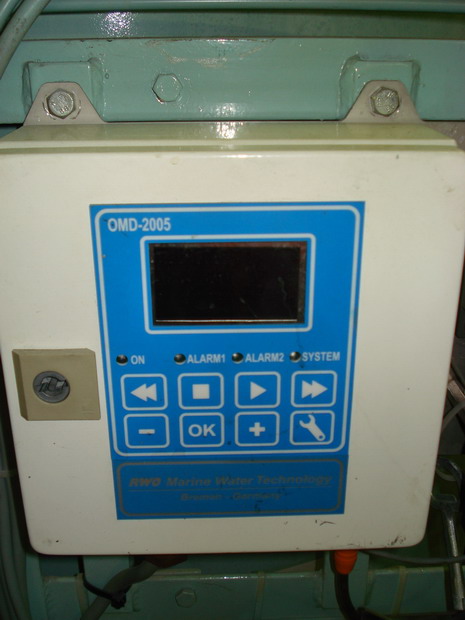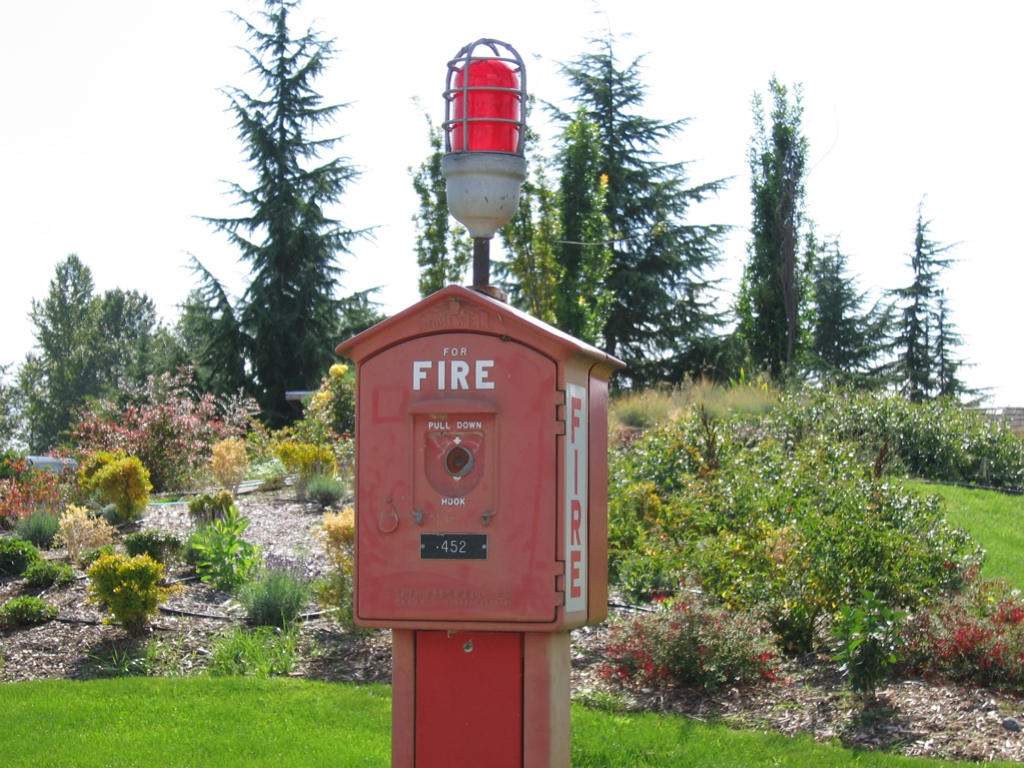|
Oil Content Meter
An oil content meter (OCM) is an integral part of all oily water separator (OWS) systems. Oil content meters are also sometimes referred to as oil content monitors, bilge alarms, or bilge monitors. OCM technology The OCM continuously monitors how much oil is in the water that is pumped out the discharge line of the OWS system. The OCM will not allow the oil concentration of the exiting water to be above the Marpol standard of 15 ppm. This standard was first adopted in 1977 with Resolution A.393(X) which was published by IMO. These standards were updated various but the most current resolution is MEPC 108(49). The oil content meter will sound an alarm if the liquid leaving the system has an unsatisfactory amount of oil in the mixture. If it is still above that standard, then the bilge water will be reentered into the system until it meets the required criteria. The OCM uses light beams to determine how oily the water in the system is. The system will then gauge the oil conc ... [...More Info...] [...Related Items...] OR: [Wikipedia] [Google] [Baidu] |
Bilge
The bilge of a ship or boat is the part of the hull that would rest on the ground if the vessel were unsupported by water. The "turn of the bilge" is the transition from the bottom of a hull to the sides of a hull. Internally, the bilges (usually used in the plural in this context) is the lowest compartment on a ship or seaplane, on either side of the keel and (in a traditional wooden vessel) between the floors. The first known use of the word is from 1513. Bilge water The word is sometimes also used to describe the water that collects in this area. Water that does not drain off the side of the deck or through a hole in the hull, typically via a scupper, drains down into the ship into the bilge. This water may be from rough seas, rain, leaks in the hull or stuffing box, or other interior spillage. The collected water must be pumped out to prevent the bilge from becoming too full and threatening to sink the ship. Bilge water can be found aboard almost every vessel. Depending ... [...More Info...] [...Related Items...] OR: [Wikipedia] [Google] [Baidu] |
MARPOL 73/78
The International Convention for the Prevention of Pollution from Ships, 1973 as modified by the Protocol of 1978, or "MARPOL 73/78" is one of the most important international marine environmental conventions. MARPOL 73/78, MARPOL is an amalgamation of the words "marine and pollution" in multiple languages and a short way to refer to the purpose of the convention. and 73/78 short for the years 1973 and 1978) It was developed by the International Maritime Organization with an objective to minimize pollution of the oceans and seas, including dumping, oil and air pollution. The original MARPOL was signed on 17 February 1973, but did not come into force at the signing date. The current convention is a combination of 1973 Convention and the 1978 Protocol, which entered into force on 2 October 1983. As of January 2018, 156 states are parties to the convention, being flag states of 99.42% of the world's shipping tonnage. All ships flagged under countries that are signatories to ... [...More Info...] [...Related Items...] OR: [Wikipedia] [Google] [Baidu] |
International Maritime Organization
The International Maritime Organization (IMO, French: ''Organisation maritime internationale'') is a specialised agency of the United Nations responsible for regulating shipping. The IMO was established following agreement at a UN conference held in Geneva in 1948 and the IMO came into existence ten years later, meeting for the first time in 1959. Headquartered in London, United Kingdom, IMO currently has 175 Member States and three Associate Members. The IMO's primary purpose is to develop and maintain a comprehensive regulatory framework for shipping and its remit today includes maritime safety, environmental concerns, legal matters, technical co-operation, maritime security and the efficiency of shipping. IMO is governed by an assembly of members which meets every two years. Its finance and organization is administered by a council of 40 members elected from the assembly. The work of IMO is conducted through five committees and these are supported by technical subcommitte ... [...More Info...] [...Related Items...] OR: [Wikipedia] [Google] [Baidu] |
Alarm Device
An alarm device is a mechanism that gives an audible, visual or other kind of alarm signal to alert someone to a problem or condition that requires urgent attention. Alphabetical musical instruments Etymology The word ''alarm'' comes from the Old French ''a l'arme'' meaning "to the arms", or "to the weapons", telling armed men to pick up their weapons and get ready for action because an enemy may have suddenly appeared. The word ''alarum'' is an archaic form of ''alarm''. It was sometimes used as a call to arms in the stage directions of Elizabethan dramas. The term comes from the Italian ''all'armi'' and appears 89 times in Shakespeare's first folio. Often explained as the off-stage sounds of conflict or disturbance, recent research suggests a bell or drum may have been used to rouse soldiers from sleep. History and development Early alarm devices were often bells, drums, other musical instruments, or any items which made unusual loud noises that attracted the attention ... [...More Info...] [...Related Items...] OR: [Wikipedia] [Google] [Baidu] |
Valve
A valve is a device or natural object that regulates, directs or controls the flow of a fluid (gases, liquids, fluidized solids, or slurries) by opening, closing, or partially obstructing various passageways. Valves are technically fittings, but are usually discussed as a separate category. In an open valve, fluid flows in a direction from higher pressure to lower pressure. The word is derived from the Latin ''valva'', the moving part of a door, in turn from ''volvere'', to turn, roll. The simplest, and very ancient, valve is simply a freely hinged flap which swings down to obstruct fluid (gas or liquid) flow in one direction, but is pushed up by the flow itself when the flow is moving in the opposite direction. This is called a check valve, as it prevents or "checks" the flow in one direction. Modern control valves may regulate pressure or flow downstream and operate on sophisticated automation systems. Valves have many uses, including controlling water for irrigation, ... [...More Info...] [...Related Items...] OR: [Wikipedia] [Google] [Baidu] |
Fuel Oil
Fuel oil is any of various fractions obtained from the distillation of petroleum (crude oil). Such oils include distillates (the lighter fractions) and residues (the heavier fractions). Fuel oils include heavy fuel oil, marine fuel oil (MFO), bunker fuel, furnace oil (FO), gas oil (gasoil), heating oils (such as home heating oil), diesel fuel and others. The term ''fuel oil'' generally includes any liquid fuel that is burned in a furnace or boiler to generate heat ( heating oils), or used in an engine to generate power (as motor fuels). However, it does not usually include other liquid oils, such as those with a flash point of approximately , or oils burned in cotton- or wool-wick burners. In a stricter sense, ''fuel oil'' refers only to the heaviest commercial fuels that crude oil can yield, that is, those fuels heavier than gasoline (petrol) and naphtha. Fuel oil consists of long-chain hydrocarbons, particularly alkanes, cycloalkanes, and aromatics. Small molecules, such as t ... [...More Info...] [...Related Items...] OR: [Wikipedia] [Google] [Baidu] |
Diesel Fuel
Diesel fuel , also called diesel oil, is any liquid fuel specifically designed for use in a diesel engine, a type of internal combustion engine in which fuel ignition takes place without a spark as a result of compression of the inlet air and then injection of fuel. Therefore, diesel fuel needs good compression ignition characteristics. The most common type of diesel fuel is a specific fractional distillate of petroleum fuel oil, but alternatives that are not derived from petroleum, such as biodiesel, biomass to liquid (BTL) or gas to liquid (GTL) diesel are increasingly being developed and adopted. To distinguish these types, petroleum-derived diesel is sometimes called petrodiesel in some academic circles. In many countries, diesel fuel is standardised. For example, in the European Union, the standard for diesel fuel is EN 590. Diesel fuel has many colloquial names; most commonly, it is simply referred to as ''diesel''. In the United Kingdom, diesel fuel for on-road use is c ... [...More Info...] [...Related Items...] OR: [Wikipedia] [Google] [Baidu] |
Emulsions
An emulsion is a mixture of two or more liquids that are normally immiscible (unmixable or unblendable) owing to liquid-liquid phase separation. Emulsions are part of a more general class of two-phase systems of matter called colloids. Although the terms ''colloid'' and ''emulsion'' are sometimes used interchangeably, ''emulsion'' should be used when both phases, dispersed and continuous, are liquids. In an emulsion, one liquid (the dispersed phase) is dispersed in the other (the continuous phase). Examples of emulsions include vinaigrettes, homogenized milk, liquid biomolecular condensates, and some cutting fluids for metal working. Two liquids can form different types of emulsions. As an example, oil and water can form, first, an oil-in-water emulsion, in which the oil is the dispersed phase, and water is the continuous phase. Second, they can form a water-in-oil emulsion, in which water is the dispersed phase and oil is the continuous phase. Multiple emulsions are also pos ... [...More Info...] [...Related Items...] OR: [Wikipedia] [Google] [Baidu] |
Marpol Annex I
Marpol Annex I is the first implementation made by Marpol 73/78, one of the most important international marine environmental conventions. The convention was designed to minimize pollution of the seas from ships. The objective of the convention is to preserve the marine environment through the complete elimination of pollution by oil and other harmful substances and the minimization of accidental discharge of such substances. The Marpol Annex I began to be enforced on October 2, 1983, and it details the prevention of pollution by oil and oily water. Marpol Annex I details the discharge requirements for the prevention of pollution by oil and oily materials. It continues to enforce the oil discharge criteria described in the 1969 amendments to the 1954 Oil Pollution Convention. It also introduces the idea ofspecial areas which are considered to be at risk to oil pollution. Discharge of oil within them have been completely outlawed but there are a few minor exceptions. Also in 2003 ... [...More Info...] [...Related Items...] OR: [Wikipedia] [Google] [Baidu] |






